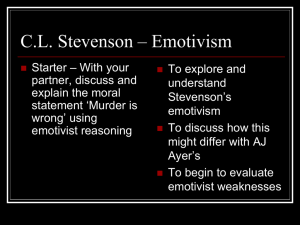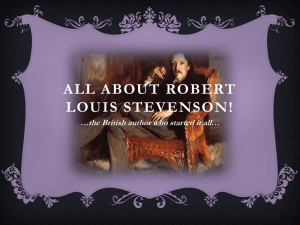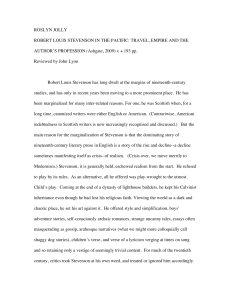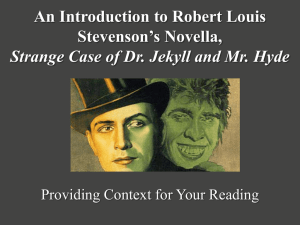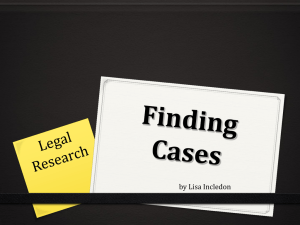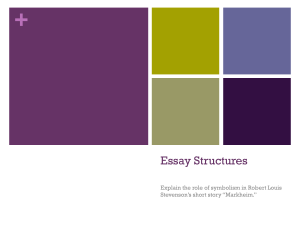The Beach of Falesa: Robert Louis Stevenson
advertisement
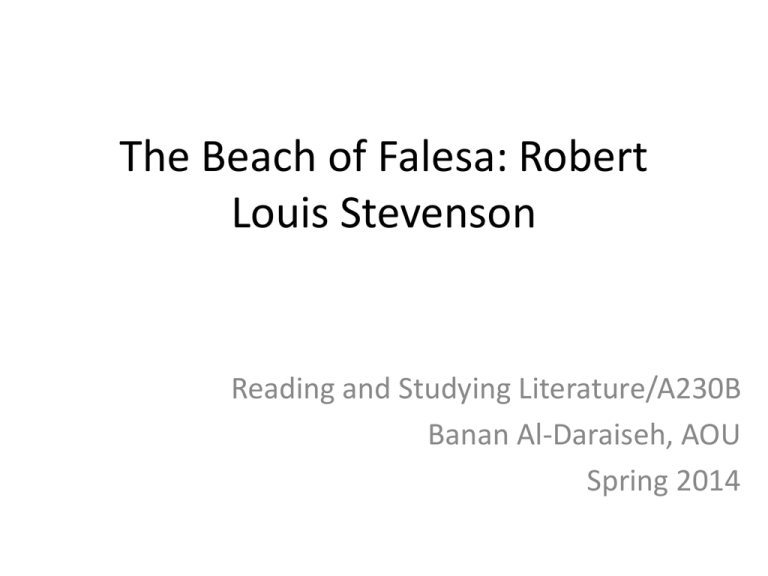
The Beach of Falesa: Robert Louis Stevenson Reading and Studying Literature/A230B Banan Al-Daraiseh, AOU Spring 2014 Other elements of Hybridity in The Beach of Falesa: New Forms of English • In his essay, The foreigner at Home,” Stevenson contends: “it is not only when we cross the seas that we go abroad…Ireland, Wales and the Scottish mountains still cling, in part, to their old Gaelic speech.” Discuss • Parts of the novella aren’t written in the Standard literary English found in serialized fiction. • Stevenson uses dialect and slang– Polynesian, mainly Samoan, ones in the narrative. • Stevenson’s story attempts REALISTICALLY to represent a new, evolving and still unstable dialect of English— Pidgin. • Pidgin: a new language that emerged out of the trading relationships on the beach between different communities (American, Chinese, European, various Pacific languages. across the Pacific. Discuss pg 453 • The British and foreign Bible Society (1804) was the first to give formal recognition to Pidgin and variations of it that became national languages in the Pacific. Examples pg 453 • For millions of people in Africa, Asia, Americas and the Pacific, their first encounter with literacy and the printed book was often through a translated Bible—Uma’s Bible in the story. • In the story, Uma uses an English-based Pidgin to communicate with her husband, Wiltshire. Also, Pidgin was used by Islanders to negotiate with outsiders. • Stevenson’s attempt to reproduce Pidgin English reflects his commitment toward REALISM in the story. Activity 4, pg 453-454: • Wiltshire and Uma’s domestic life is depicted in a realistic way—a typical everyday marital argument; Wiltshire speaking in Standard colloquial English; Uma using simple structure of Pidgin English; different perspectives on the Bible’s ability to protect reflects both miscommunication and a common point of reference. See page 454 Stevenson in the South Pacific • Stevenson’s emigration to Samoa and his settlement in Vailima generated both positive and negative reactions. • Stevenson became the exotic, Romantic writertraveller—like Lord Byron and Shelley. His life generated publicity and sales. • His emigration intensified the Victorian anxieties about propriety, both morally and literarily. • Stevenson “going native?” • Some of his friends, writers and critics, among them Sidney Colvin and Henry James, thought that his migration negatively effected his writings. Discuss • Stevenson rebutted accusations about the quality of his writings being effected negatively, but he wasn’t willing to defend himself against insinuations that he was “going native.” why? Discuss. Pg 455 Stevenson’s fascination with the Island life was seen as evidence of his “supposed decline, his exposure to a foreign land, and his repudiation of Western culture.” • Literarily, Stevenson bought Hawaiian grammars, collected and transcribed local poetry and myth, used Polynesian epic verse in his poetry, read travel books on the region, and learn Samoan. • Stevenson immersed himself in all aspects of Pacific life. Discuss figure 8.3, Pg 456. Why was the Stevensons’ socialization with the Butaritarian couple, Nei Takautiand Nan Tok seen by the Victorians as scandalous? • “Contact Zone,” a term used by the critic Mary Louis Partt to refer to “social spaces where cultures meet, clash, and grapple with each other. Often in context of highly asymmetrical relations of power…etc” pg 457 • The beach, in The Beach of Falesa, is considered the contact zone where the whole narrative unfolds— where trade and conversation and all other forms of exchange took place. -the contact zone both had a negative and positive effect on the English subject. Discuss examples from Stevenson’s life and the life of the characters in the novella. Pg 458 -racial and national categories, as with the ideas of home and abroad, get destabilized by the realities of trade, imperialism, expansion, emigration, and settlement • Despite that Wiltshire’s domestic life reflected the concept of “contact zone--” living the lifestyle of the Islanders, his interracial marriage to Uma, and their offspring (hybrid children), he continues expressing racial prejudice till the end of the story. Discuss pg 459 • Also, Stevenson’s life in Vailima was ambiguous: It did not conform to the standards of Victorian domestic life nor the long-lasting traditions of village life in Samoa. Discuss 460-61
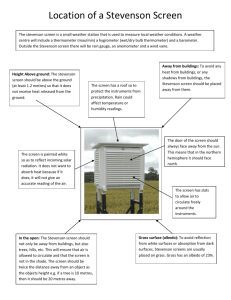
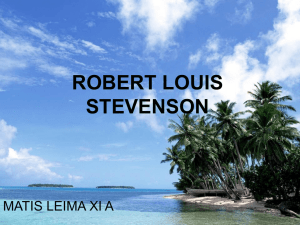

![[discussion day and time] [date turned in] 5 A Summary of Section I of I](http://s3.studylib.net/store/data/008362829_1-ae4dd7e4bddee9f7323f094970aefa02-300x300.png)
